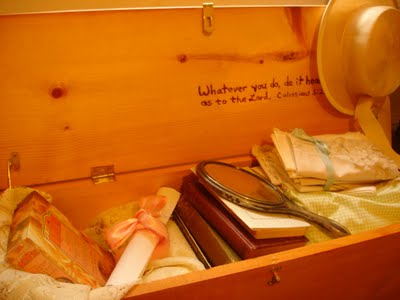
As we have been talking this past week on Hope Chests, I can think of no commoner and more popular item to be found within than a pillow or pillowcase!
Currently, I am working on adding items to my personal Hope Chest, and as I was going through and putting together sheet sets, I found one set without a pillowcase. With some extra white material, I have sewn my own and will share how I did so now. (Along with the one step extra to make a pillow.)
Materials:
Fabric (color of choice, texture of choice, etc)
Fabric Scissors
Ruler, Tape Measure, or Pattern
Pencil
Pins (small or large, whichever meets your preference)
Sewing Machine w/ Thread (or Thread/Needle, if you are doing this by hand)
Prior to sewing, wash and dry your fabric, so that it can shrink.
Step One: Cutting–
Fold your fabric of choice inside out and in half. Using your fabric scissors, cut your fabric in the pillowcase shape and dimensions of your choice. You may need a pattern or a ruler to do this. All I did was take another pillowcase, lay it on top of my fabric, trace with a pencil about a quarter of an inch past the edge of the pillowcase (for hemming), and then cut along that line.
**Take notice, that I also cut on the fold (but not the fold itself), so that instead of having to hem four sides and close three, I only have to hem 3 sides and close two.

The fabric for the pillowcase is now all cut out. I will take off my pattern pillowcase, and proceed to the next step.
Step Two: Pinning–
Next, I pin my fabric (soon to be pillowcase) along the two edges that I will close up, one length-wise and one width-wise. (I will use one width-wise edge for the opening to put the pillow in, and the other length-wise is along a fold, so it is already closed. If your second length-wise edge is NOT closed or folded, you would hem it as you do the first length-wise edge.)

Shown here are a few of my pins, turning over the fabric to make neat, straight hems. I only place pins every so often, and though it APPEARS somewhat turned up, when you are running the fabric through the sewing machine, it lies down flat.
Now that I have the length-wise and width-wise edges pinned for hemming, I will pin the TOP edge of where my opening will be. I do NOT combine the two edges. See the picture below.

I now have pins on one width-wise, one length-wise, and on the TOP material of where my opening to insert the pillow is. Notice the un-hemmed second layer on the left.
Still on the Pinning Step, I next pin that second layer, which I had left out.

This is the second layer I am talking about. I will pin it by itself, just as I pinned the layer on top of it by itself.
The finished Pinning looks like this:
I lay my top layer on my second layer. Both have their own SEPARATE hemming pins, so that when I sew, I will not sew them together, thus closing my opening.
**If following directions for pillow, do not hem the two layers separately, for they will eventually be closed together!**
Step Three: Sewing
Finally–it is time to sew! First I sew my two edges (three if you do not have a fold), and then I sew my two separate layers for the opening.

I am sewing my edges here, being careful to remove my pins before the machine runs over it. (That normally messes up my machine, but I have seen some that can run right over the pins.)
And to finish my pillow case, I place the opening around my sewing machine and just feed it through, thus hemming the two separate layers, which are continuously connected

Now I can sew my opening, not closed--but hemmed. Turn the fabric right side out, and wa-la! I have a new, homemade pillowcase!
**If following directions for pillow, do not sew all the way around. Leave a space open large enough for you to add your stuffing.**
DO NOT FORGET TO TURN THE FABRIC RIGHT SIDE OUT, WHEN YOU ARE FINISHED! (This applies to pillow-making, as well.)
**Pillow Extra Step Four: Stuffing–
The last step to making your pillow is to push the stuffing of your choice into your material, and once you have added the amount of your choice, sew up that small space by which you put the stuffing in and TA-DA! You have a new, homemade pillow!
















